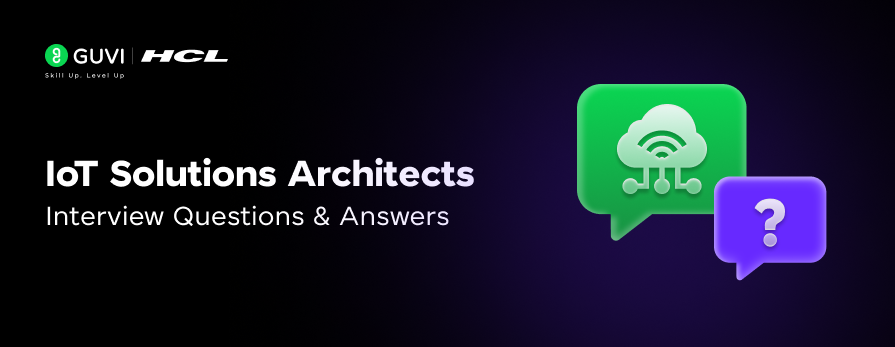
Top 50+ IoT Solutions Architect Interview Questions and Answers
Mar 06, 2025 12 Min Read 1691 Views
(Last Updated)
The role of an IoT Solutions Architect is at the cutting edge of modern technology, requiring a deep understanding of interconnected systems, data flows, and emerging technologies. Whether you’re a fresh graduate stepping into the IoT domain, an intermediate professional honing your expertise, or a seasoned expert aiming to solve large-scale IoT challenges, interview preparation is crucial.
This article provides a comprehensive list of the top IoT Solutions Architect Interview Questions and Answers, meticulously categorized to cater to all skill levels.
For your ease and thorough preparation, I have divided all the questions into various sections for all levels and then on to more sectional ones such as highly technical, behavioral, architectural, and more. Let’s get started right away.
Table of contents
- Top IoT Solutions Architect Interview Questions and Answers (Section-Wise)
- Questions for Freshers (All your basics)
- Questions for Almost Experts (Intermediate level skills)
- Questions for Experts
- Technical Deep-Dive Questions
- Scenario-Based Questions
- Problem-Solving Questions
- Architectural and Design Questions
- Cross-Functional and Strategic Questions
- Behavioral and Leadership Questions
- Concluding Thoughts…
Top IoT Solutions Architect Interview Questions and Answers (Section-Wise)
I have divided all these important IoT interview questions and answers into various sections for your ease of learning, I recommend starting with the basics and then going through all the sections one by one so that you can gain a well-rounded knowledge of how these interviews are undertaken and how much and what you should prepare.
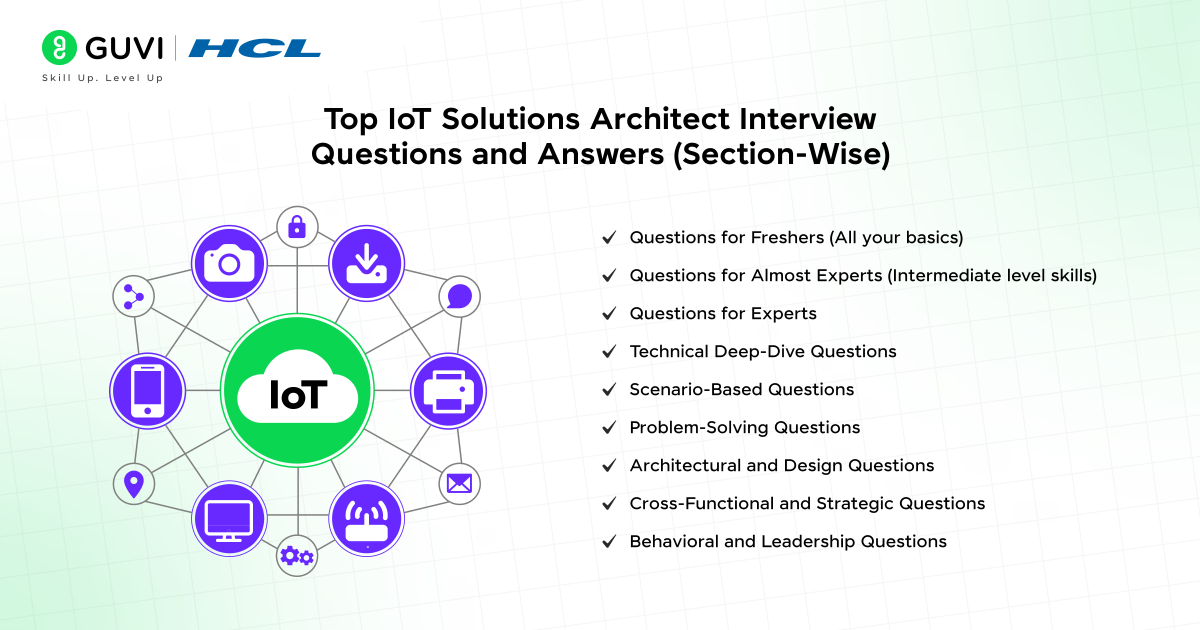
1. Questions for Freshers (All your basics)
This is a must-know section for all IoT professionals, here we cover a range of basic questions:
1) What is IoT, and can you explain its basic architecture?
Answer: The Internet of Things (IoT) is a network of interconnected devices that collect, share, and process data through the internet. It enables real-time automation and decision-making across various domains, including smart homes, healthcare, and industrial systems. Basic Architecture Layers:
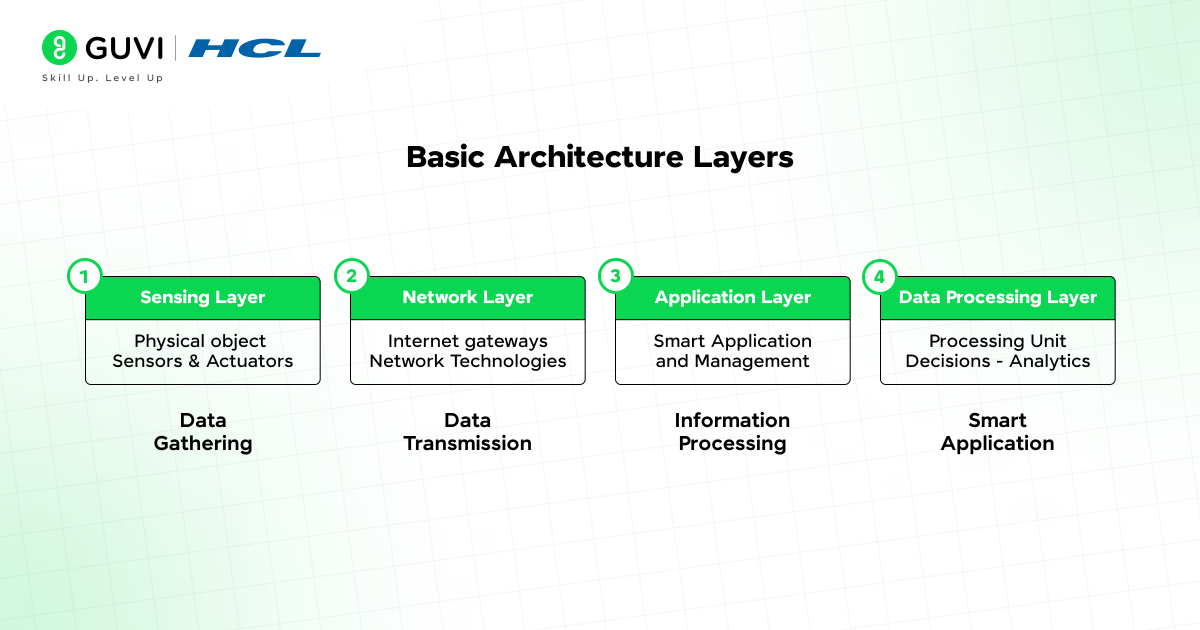
- Sensing Layer:
- Includes sensors and actuators.
- Responsible for data collection from the physical environment (e.g., temperature, humidity).
- Network Layer:
- Provides connectivity using protocols like Wi-Fi, Bluetooth, and cellular networks.
- Transmits data between devices and systems.
- Data Processing Layer:
- Handles data aggregation, filtering, and analysis.
- May include edge computing and cloud processing.
- Application Layer:
- User-facing layer delivering actionable insights and control.
- Includes dashboards, mobile apps, and interfaces.
- User-facing interfaces for data visualization and control.
2) How does an IoT device connect to the internet?
Answer: IoT devices connect using communication protocols such as:
- MQTT (Message Queuing Telemetry Transport): Lightweight and ideal for limited bandwidth.
- HTTP/HTTPS: Widely used but resource-intensive.
- CoAP (Constrained Application Protocol): Optimized for low-power devices.
Connectivity options include Wi-Fi, Bluetooth, Ethernet, and cellular networks like LTE or 5G.
3) What are some examples of IoT applications?
Answer:
- Smart Homes: Devices like Nest thermostats, Ring doorbells.
- Industrial Automation: Predictive maintenance using connected sensors.
- Healthcare: Wearables monitoring vitals like heart rate or oxygen levels.
- Agriculture: Smart irrigation systems leveraging soil moisture data.
4) What is the role of sensors and actuators in IoT?
Answer:
- Sensors: Gather environmental data such as temperature, humidity, or motion.
- Actuators: Respond to sensor data by performing physical actions, like adjusting a valve or moving a robotic arm.
5) What challenges does IoT face regarding security?
Answer: Common security challenges include:
- Unauthorized Device Access: Devices with default credentials are vulnerable.
- Data Interception: Unencrypted transmissions can be intercepted.
- Firmware Exploits: Outdated firmware can lead to vulnerabilities.
Mitigation strategies include strong authentication, encryption, and regular updates.
6) What is the difference between IoT and M2M (Machine to Machine)?
Answer: IoT involves connected devices with internet protocols, while M2M is direct communication between devices without internet dependency.
7) What is an IoT gateway, and why is it important?
Answer: IoT gateways bridge devices and the cloud, handling data aggregation, protocol translation, and initial processing.
2. Questions for Almost Experts (Intermediate level skills)
This section consists questions that can most likely be answered by IoT professionals who have been around for a while:
8) How would you ensure low latency in an IoT deployment?
Answer: Techniques include using edge computing for local data processing, lightweight protocols like MQTT, and optimizing network routing:
- Edge Computing: Process data locally to reduce cloud dependency.
- Lightweight Protocols: Utilize MQTT or CoAP for efficient communication.
- Optimized Routing: Ensure minimal network hops and prioritize traffic for critical applications.
9) Can you explain the role of fog computing in IoT?
Answer: Fog computing extends cloud capabilities to edge devices, enabling localized:
- Data Processing: Reduces latency by analyzing data closer to the source.
- Storage: Ensures faster data access.
- Analytics: Enables real-time decision-making for applications like autonomous vehicles or industrial IoT.
10) What strategies would you use for scaling an IoT solution?
Answer:
- Serverless Architectures: Scale on demand without managing infrastructure.
- Data Partitioning: Distribute large datasets across multiple storage nodes.
- Load Balancing: Evenly distribute network and computational workloads.
11) How do you integrate AI/ML in IoT for predictive maintenance?
Answer:
- Deploy sensors to collect equipment data.
- Use edge devices for real-time anomaly detection.
- Train ML models on historical data to predict failures.
12) What are the critical components of IoT security?
Answer: Critical components of IoT security include:
- Device Authentication: Ensuring devices are authenticated before accessing the network through secure credentials or certificates.
- Data Encryption: Using robust protocols like TLS or AES to secure data in transit and at rest.
- Secure Boot and Firmware Updates: Preventing unauthorized code execution by verifying software integrity and enabling regular security patches.
- Access Control: Implementing least privilege policies to limit unauthorized access.
- Anomaly Detection: Using AI/ML-based intrusion detection systems for real-time threat identification.
- Network Segmentation: Isolating devices to prevent lateral threats.
- End-to-End Security: Combining physical, network, and application-layer protections to safeguard the entire ecosystem.
13) How would you optimize battery life in IoT devices?
Answer: Use techniques like:
- Duty Cycling: Minimize active communication time.
- Efficient Protocols: Use low-power communication like Zigbee or Bluetooth LE.
- Hardware Optimization: Utilize energy-efficient microcontrollers and sensors.
14) How do you decide between on-premise and cloud-based IoT solutions?
Answer:
- On-premise: Ideal for data-sensitive environments where privacy, regulatory compliance, and low-latency processing are critical. It provides direct control over infrastructure but involves higher upfront costs and maintenance responsibilities.
- Cloud-based: Suitable for scalable, globally distributed systems requiring flexibility and reduced infrastructure overhead. It offers cost-efficiency with pay-as-you-go models and robust remote accessibility but may introduce latency and data sovereignty concerns.
3. Questions for Experts
All the IoT pros know the answer to these and incase you need a revisit, we’ve answered all the question in-depth:
15) How would you architect an IoT system that supports billions of devices?
Answer: To architect an IoT system supporting billions of devices, employ a microservices architecture for modularity and scalability. Use Kubernetes to orchestrate containers and distributed databases like Cassandra for efficient data management. Integrate Apache Kafka for high-throughput messaging and edge computing to reduce latency.
Implement sharded storage, load balancing, and serverless computing for dynamic scaling. Ensure robust security with end-to-end encryption, device authentication, and regular updates. Leverage 5G and network slicing for enhanced connectivity. Establish monitoring and alerting systems to maintain operational efficiency and prevent bottlenecks.
16) Describe the steps you’d take to secure an IoT network from DDoS attacks.
Answer: To secure an IoT network from DDoS attacks, implement the following measures:
- Rate Limiting: Restrict traffic volume to prevent overwhelming the network.
- Anomaly Detection: Use AI/ML tools to identify unusual traffic patterns early.
- Traffic Filtering: Block malicious IP addresses and suspicious traffic at gateways.
- Network Segmentation: Isolate IoT devices from critical systems to minimize impact.
- Secure Protocols: Enforce TLS/SSL for secure data transmission.
- Firmware Updates: Regularly patch device vulnerabilities to prevent exploitation.
17) How do you ensure data integrity in IoT systems?
Answer: To ensure data integrity in IoT systems:
- End-to-End Encryption: Secure data in transit using protocols like TLS/SSL.
- Data Validation: Use hash functions (e.g., SHA-256) to detect tampering.
- Tamper-Proof Logging: Leverage blockchain for immutable and transparent data records.
- Device Authentication: Ensure only authenticated devices transmit or receive data.
- Redundant Systems: Maintain backup copies and implement consistency checks.
- Regular Audits: Periodically inspect data flows and logs for anomalies.
- Secure Firmware Updates: Prevent unauthorized code modifications to IoT devices.
18) What are the trade-offs of using edge computing versus centralized cloud computing in IoT?
Answer:
- Edge: Reduces latency, saves bandwidth, but increases hardware costs and complexity.
- Cloud: Centralized data management, easier to scale, but higher latency and bandwidth usage.
19) How would you integrate 5G into an existing IoT ecosystem?
Answer:
- Leverage 5G’s low latency and high bandwidth for real-time applications.
- Use network slicing to prioritize critical IoT workloads.
- Update device firmware for 5G compatibility.
20) What is your approach to troubleshooting a large-scale IoT system?
Answer:
- Use telemetry data to identify patterns and anomalies.
- Isolate failing components via network segmentation.
- Perform root cause analysis using event logs.
21) How would you design an IoT solution for a critical application like autonomous vehicles?
Answer:
- Use edge nodes for real-time decision-making.
- Implement V2X (Vehicle-to-Everything) communication for data exchange.
- Ensure redundancy with failover mechanisms to prevent system failure.
4. Technical Deep-Dive Questions
22) Explain how MQTT ensures reliability in IoT communication.
Answer: MQTT provides reliability through Quality of Service (QoS) levels:
- QoS 0: “At most once” delivery, no acknowledgment.
- QoS 1: “At least once” delivery, acknowledged.
- QoS 2: “Exactly once” delivery, ensures message duplication is avoided.
The protocol also uses persistent sessions and retained messages to ensure critical data isn’t lost during disconnections.
23) What are the key differences between edge computing and fog computing in IoT?
Answer:
- Edge Computing: Data processing occurs directly on edge devices (e.g., sensors).
- Fog Computing: Data is processed in a network layer closer to devices but not on the edge, using intermediate nodes or gateways.
Fog computing is more scalable and supports resource pooling, while edge computing reduces latency further by processing closer to the source.
24) How does LoRaWAN manage device communication in low-power IoT networks?
Answer: LoRaWAN uses Adaptive Data Rate (ADR) to optimize data rates and battery life. Devices use a chirp spread spectrum modulation technique, ensuring long-range communication even with low power consumption. It also implements bidirectional communication and network security via AES-128 encryption.
25) Describe the role of a digital twin in industrial IoT (IIoT).
Answer: A digital twin replicates physical assets digitally, enabling real-time monitoring, predictive maintenance, and operational simulations. It helps optimize processes, improve efficiency, and reduce downtime by providing actionable insights into system behavior without physical intervention.
GUVI’s Essentials of IoT Course is ideal for learners aiming to master IoT concepts and prepare for Solutions Architect interviews. This course offers hands-on projects, in-depth knowledge of IoT frameworks, and practical exposure to top tools like Arduino, Raspberry Pi, and MQTT protocols.
With expert guidance and industry-relevant curriculum, you’ll gain the skills to design scalable IoT solutions and advance in IoT-driven careers. Perfect for beginners and professionals alike, it ensures a solid foundation in IoT essentials.
26) How is data integrity maintained in IoT cloud platforms?
Answer: Data integrity in IoT cloud platforms is achieved using:
- Checksum algorithms for error detection during transmission.
- Blockchain technology for immutable record-keeping.
- End-to-end encryption to prevent tampering.
- Access control policies ensuring authorized access.
5. Scenario-Based Questions
27) You are designing an IoT system for a smart city. How would you manage data flow from thousands of sensors in real time?
Answer:To manage real-time data flow from thousands of sensors in a smart city IoT system:
- Edge Computing: Process and filter data locally at edge nodes to reduce cloud dependency and minimize latency.
- Message Brokers: Use scalable systems like Apache Kafka or RabbitMQ to manage data streams and ensure high throughput.
- Data Partitioning: Organize data into partitions based on sensor type or location for parallel processing.
- Load Balancing: Distribute incoming data across multiple servers to prevent bottlenecks.
- Time-Series Databases: Store sensor data efficiently using databases like InfluxDB or TimescaleDB designed for high write speeds.
- Dynamic Scaling: Employ serverless architectures and cloud platforms (AWS Lambda, Azure IoT Hub) for elastic scaling.
- Real-Time Analytics: Integrate tools like Apache Flink or Spark Streaming for immediate insights and anomaly detection.
- Priority Queues: Assign priority levels to critical data streams to ensure timely processing during high traffic.
This architecture ensures efficient, reliable, and scalable data management.
28) A manufacturing client wants to integrate predictive maintenance in their factory. What solution would you propose?
Answer: To integrate predictive maintenance for your manufacturing client’s factory, I recommend the following solution:
Proposed Solution:
- IoT Sensors Deployment: Install sensors on critical machinery to monitor key parameters such as temperature, vibration, pressure, and motor current.
- Data Acquisition and Communication:
- Use IoT gateways to aggregate sensor data and transmit it securely to a cloud or edge computing platform.
- Employ communication protocols like MQTT or OPC UA for seamless data transfer.
- Data Analysis with AI/ML:
- Leverage historical data to train machine learning models capable of identifying patterns and predicting failures.
- Implement real-time analytics at the edge for low-latency anomaly detection.
- Centralized Monitoring Platform:
- Deploy a predictive maintenance dashboard to visualize equipment health, receive alerts, and generate reports.
- Integration with Existing Systems:
- Ensure compatibility with existing ERP and SCADA systems for unified operational insights.
- Outcome and Benefits:
- Minimize unplanned downtime by predicting and addressing issues before failures occur.
- Optimize maintenance schedules to reduce costs and enhance operational efficiency.
This solution aligns with the manufacturing client’s goal by combining IoT, AI/ML, and cloud technologies for efficient predictive maintenance.
29) How would you handle security for a healthcare IoT device transmitting sensitive patient data?
Answer: To handle security for a healthcare IoT device transmitting sensitive patient data, implement the following measures:
- Data Encryption: Use end-to-end encryption protocols like TLS/SSL to secure data during transmission.
- Authentication and Authorization: Require multi-factor authentication and role-based access control to ensure only authorized users access the device and its data.
- Secure Storage: Store sensitive data on the device or cloud using strong encryption algorithms such as AES-256.
- Regular Firmware Updates: Ensure the device firmware is regularly updated to patch vulnerabilities.
- Network Security: Utilize VPNs and firewalls to protect communication channels and isolate sensitive systems.
- Secure Boot and Hardware: Implement secure boot mechanisms to prevent unauthorized firmware modifications.
- Compliance with Standards: Adhere to healthcare regulations like HIPAA or GDPR for data security and privacy.
These strategies collectively ensure the safety and integrity of patient data in healthcare IoT devices.
30) Describe a solution for deploying IoT in a remote agricultural area with limited connectivity.
Answer: Deploying IoT in a remote agricultural area with limited connectivity involves using edge computing to process data locally and reduce dependency on the internet. Sensors can monitor soil moisture, temperature, and weather conditions, while LoRaWAN or NB-IoT provides low-power, long-range communication.
Solar-powered devices ensure sustainability, and a gateway aggregates data, transmitting only critical information during brief connectivity periods via cellular or satellite links. Farmers can access insights through offline-capable mobile apps synchronized during connectivity windows. This setup ensures real-time decision-making with minimal infrastructure dependency.
31) Your IoT system experiences latency issues. How would you troubleshoot?
Answer: To troubleshoot latency issues in an IoT system:
- Identify Network Bottlenecks:
- Analyze network performance using monitoring tools to detect slow links or overloaded routers.
- Check for excessive traffic or packet loss.
- Evaluate Protocol Efficiency:
- Ensure lightweight protocols like MQTT or CoAP are used for low-power devices.
- Minimize unnecessary handshake or data overhead.
- Optimize Edge Computing:
- Process data locally at edge nodes to reduce round-trip latency to the cloud.
- Verify Hardware Performance:
- Test IoT devices and gateways for hardware limitations affecting data processing speeds.
- Improve Data Routing:
- Implement optimized routing algorithms and reduce network hops.
- Review System Scalability:
- Ensure the system architecture can handle the current volume of devices and data.
- Update Firmware and Software:
- Ensure IoT devices, gateways, and applications are running the latest versions to improve performance and bug fixes.
- Test Load Balancing:
- Use load balancers to evenly distribute workloads across servers or gateways.
By systematically analyzing these components, latency sources can be identified and mitigated effectively.
6. Problem-Solving Questions
32) A device in your IoT network is sending duplicate data. How would you resolve this?
Answer: To resolve an IoT device sending duplicate data, follow these steps:
- Check Firmware: Ensure the device firmware is updated to address bugs causing duplicate transmissions.
- Implement De-duplication Logic: Add server-side or gateway logic to filter duplicate messages based on unique message IDs or timestamps.
- Adjust Reporting Interval: Reconfigure the device’s reporting frequency to avoid excessive data overlaps.
- Verify Network Latency: Assess the network for delays that could cause resending of unacknowledged messages.
- Review Protocol Settings: Ensure correct configurations for MQTT or CoAP, especially regarding quality of service (QoS) levels and retransmission settings.
This approach ensures efficient data management and reduces network overhead.
33) How would you reduce the energy consumption of IoT sensors in a battery-constrained environment?
Answer: Reducing the energy consumption of IoT sensors in a battery-constrained environment involves the following techniques:
- Duty Cycling: Minimize sensor active time by alternating between active and sleep modes.
- Energy-Efficient Communication Protocols: Use low-power protocols like Zigbee, Bluetooth Low Energy (BLE), or LoRaWAN.
- Data Aggregation: Reduce communication overhead by aggregating and transmitting data in batches instead of sending it continuously.
- Event-Triggered Operations: Activate sensors only when specific thresholds or triggers are met.
- Optimized Sampling Rates: Adjust the frequency of data collection to the minimum required for accuracy.
- Low-Power Hardware: Use energy-efficient microcontrollers and sensors optimized for low power consumption.
- Power Management ICs: Incorporate ICs that manage and optimize power usage.
These methods help extend battery life while maintaining performance.
34) An IoT system you deployed is generating inconsistent data. What steps would you take?
Answer: To address inconsistent data in an IoT system, follow these steps:
- Check Device Calibration: Verify that all sensors are calibrated correctly and functioning as expected. Replace faulty devices if needed.
- Inspect Network Connectivity: Ensure stable communication between devices, gateways, and the cloud. Look for packet loss or latency issues.
- Analyze Data Logs: Examine logs to identify patterns, anomalies, or timestamps of inconsistencies.
- Validate Data Processing: Review data transformation algorithms and ensure the logic is not introducing errors.
- Cross-Verify with External Data: Compare collected data with a reliable reference source or manual measurements.
- Filter Noisy Data: Implement preprocessing techniques like smoothing or filtering to remove outliers.
- Implement Redundancy: Deploy multiple sensors to measure the same parameter, then average the results to improve reliability.
- Test Firmware and Updates: Ensure the firmware is up-to-date and does not introduce bugs affecting data collection.
- Monitor Environmental Factors: Check for environmental changes (e.g., temperature, humidity) that may impact sensor accuracy.
- Run Diagnostics: Use diagnostic tools or scripts to assess hardware and software integrity.
35) How would you ensure scalability in an IoT solution for a growing user base?
Answer: To ensure scalability in an IoT solution for a growing user base, consider the following strategies:
- Microservices Architecture: Break the solution into modular, independent services that can scale individually.
- Cloud-Based Infrastructure: Utilize serverless computing and dynamic scaling capabilities of cloud platforms.
- Efficient Protocols: Implement lightweight communication protocols like MQTT or CoAP for low overhead.
- Data Partitioning and Sharding: Distribute and manage large datasets across multiple storage nodes.
- Edge Computing: Offload processing to edge devices to reduce cloud dependency and minimize latency.
- Load Balancing: Employ load balancers to distribute network and compute resources effectively.
- Containerization: Use tools like Docker and Kubernetes for efficient resource allocation and orchestration.
These approaches enable horizontal and vertical scaling to accommodate increasing users while maintaining performance.
36) A device in your IoT network has been compromised. How do you mitigate the risk?
Answer: To mitigate the risk of a compromised device in your IoT network:
- Isolate the Device: Disconnect the compromised device from the network immediately to prevent further spread or data exfiltration.
- Analyze the Breach: Perform a forensic analysis to determine how the device was compromised and identify potential vulnerabilities.
- Update Credentials and Firmware: Reset device credentials and update its firmware or software to patch vulnerabilities.
- Monitor Network Traffic: Use intrusion detection systems (IDS) to monitor the network for anomalous behavior that could indicate further issues.
- Implement Network Segmentation: Restrict access between IoT devices and critical systems to minimize the impact of future breaches.
- Harden Security: Strengthen authentication methods, enable encryption, and ensure all devices follow security best practices.
- Review Incident Response Plan: Update protocols based on lessons learned to improve future readiness.
7. Architectural and Design Questions
37) What are the principles of designing a fault-tolerant IoT system?
Answer: Designing a fault-tolerant IoT system is crucial for ensuring reliability and availability, particularly in critical applications. Here are the key principles:
- Redundancy: Implement duplicate components or subsystems, such as backup sensors, power sources, and communication paths, to prevent single points of failure.
- Error Detection and Correction: Use error detection algorithms, checksums, or redundancy protocols like CRC (Cyclic Redundancy Check) to identify and correct data transmission errors.
- Edge Computing: Process data locally at the edge to reduce reliance on centralized cloud systems. This helps in minimizing latency and ensures the system can function even if cloud communication fails.
- Fault Isolation: Design the system such that faults in one component or node don’t propagate to others. This can be achieved through network segmentation and ensuring that critical services have isolated failure domains.
- Failover Mechanisms: Implement automatic failover systems to switch to backup resources, networks, or devices without interrupting service. This could include mechanisms for switching between cellular and Wi-Fi networks.
- Data Backup and Recovery: Regularly back up critical data, and have a recovery strategy in place to restore the system to a functional state after a failure.
- Monitoring and Alerts: Continuous monitoring of system health, including hardware and software, with proactive alerting helps detect potential failures early and allows for preemptive action.
- Scalability: Ensure that the system can scale horizontally, meaning more devices or resources can be added without significantly affecting system stability.
By applying these principles, IoT systems can maintain high availability and minimize downtime, even in the event of component failures.
38) How would you design an IoT system for a high-volume e-commerce warehouse?
Answer: Designing an IoT system for a high-volume e-commerce warehouse requires a comprehensive approach to efficiently manage inventory, track shipments, and optimize operations in real-time. Here’s a brief outline:
- Sensors and RFID Tags:
Use RFID tags on products and sensors on shelves to automatically track inventory and product movement. This allows for accurate stock counts and reduces human errors. - Edge Computing for Real-Time Processing:
Deploy edge computing to process data locally on devices. This minimizes latency and ensures real-time decision-making for critical operations like inventory management and order fulfillment. - Connectivity and Communication Protocols:
Use low-power communication protocols such as LoRaWAN for long-range connections between devices, and Wi-Fi for high-density areas where faster data transmission is needed. - Cloud Integration for Data Analysis:
Integrate the IoT system with cloud platforms (e.g., AWS IoT, Microsoft Azure IoT) to store large volumes of data. This allows for advanced analytics, such as predictive maintenance of warehouse equipment and automated restocking alerts. - Automated Actuators and Robotics:
Implement actuators and robotic systems for automating tasks like sorting, packing, and moving products. These devices can be controlled based on real-time data from the IoT network. - Security Measures:
Implement strong security protocols like end-to-end encryption, secure boot mechanisms for devices, and regular firmware updates to protect sensitive inventory data from breaches and unauthorized access. - Scalability:
Design the system to scale easily by adopting cloud-based infrastructure and modular components. This ensures that as the warehouse grows, the IoT system can accommodate increased device numbers and data throughput without performance degradation.
This design allows for seamless, efficient, and secure operation of a high-volume e-commerce warehouse while ensuring scalability for future growth.
39) Explain how microservices architecture benefits IoT applications.
Answer: Microservices architecture provides several key benefits for IoT applications:
- Scalability: Each microservice can be independently scaled, allowing IoT systems to handle increasing device loads without affecting the entire system. This flexibility is crucial when dealing with millions of IoT devices, ensuring that specific services, such as data collection or processing, can be scaled as needed.
- Modularity: By breaking down the application into smaller, independent services, each responsible for a specific function (e.g., data ingestion, processing, or device management), developers can update or replace individual services without impacting the entire IoT system. This enables quicker updates and maintenance.
- Fault Isolation: If one microservice fails, it doesn’t necessarily bring down the entire IoT application. This isolated failure management is critical for high-availability requirements in IoT systems, especially in critical use cases like healthcare or industrial automation.
- Flexibility with Technology Choices: Each microservice can be built using the most suitable technology stack for the task at hand. For example, data processing might require high-performance computing, while device communication might benefit from lightweight protocols. This flexibility can optimize resource usage and performance.
- Faster Development and Deployment: With microservices, different teams can work on separate components concurrently, speeding up development cycles. Additionally, continuous integration and deployment (CI/CD) pipelines work well with microservices, ensuring rapid updates and innovations without disrupting service.
In the context of IoT, where various devices and applications need to interact efficiently, microservices help provide an agile, scalable, and maintainable framework for handling complex systems.
40) How would you design a secure data pipeline for IoT devices?
Answer: To design a secure data pipeline for IoT devices, consider the following steps:
- Device Authentication and Authorization: Ensure that IoT devices are securely authenticated using methods like mutual TLS or asymmetric key encryption to prevent unauthorized access.
- Secure Communication: Use encryption protocols such as TLS or IPSec for data transmission between IoT devices, gateways, and the cloud to protect against data interception and man-in-the-middle attacks.
- Data Integrity and Validation: Implement hashing and checksums to verify the integrity of the data during transmission. This ensures that the data has not been altered or corrupted.
- Edge Processing and Data Filtering: Use edge computing for local data processing to reduce the amount of sensitive data transmitted and minimize exposure. Apply filtering to send only relevant data to the cloud.
- Access Control: Implement role-based access control (RBAC) to ensure that only authorized users or devices have access to specific parts of the system.
- Data Storage Security: Encrypt data at rest in the cloud and implement access control measures to protect sensitive data from unauthorized access.
- Continuous Monitoring and Auditing: Employ continuous monitoring tools to track data flows, device behaviors, and network traffic for any suspicious activities. Regularly audit logs for compliance and security anomalies.
- Firmware Updates: Enable secure over-the-air (OTA) updates for IoT devices to patch vulnerabilities and improve security over time.
By implementing these practices, you can ensure the security of the data pipeline across all stages, from collection to transmission and storage.
41) What are the best practices for designing low-latency IoT systems?
Answer: To design low-latency IoT systems, follow these best practices:
- Edge Computing: Process data locally at the edge to minimize round-trip communication with the cloud.
- Efficient Communication Protocols: Use lightweight protocols like MQTT or CoAP, which minimize overhead.
- Optimized Data Transmission: Implement data compression to reduce packet sizes and network load.
- Real-Time Operating Systems (RTOS): Use RTOS for predictable task execution.
- Caching and Preprocessing: Cache data and preprocess at the edge to reduce redundant processing.
- Network Optimization: Leverage high-speed, low-latency networks like 5G, and ensure proper load balancing across the infrastructure.
- Quality of Service (QoS): Implement QoS policies to prioritize critical IoT traffic.
These practices help achieve real-time response and reduce delay, critical for applications like autonomous vehicles and smart manufacturing.
8. Cross-Functional and Strategic Questions
42) How do you align IoT solutions with business goals?
Answer:
- Collaborate with stakeholders to define KPIs.
- Design use cases that directly impact efficiency and revenue.
- Prioritize cost-effective solutions without compromising quality.
43) How do you ensure compliance with industry regulations in IoT projects?
Answer:
- Conduct regular compliance audits.
- Integrate regulatory requirements (e.g., GDPR, HIPAA) into system design.
- Provide thorough documentation for audits.
44) How do you manage cross-functional teams in an IoT project?
Answer:
- Establish clear communication protocols.
- Use agile methodologies to ensure iterative progress.
- Encourage knowledge-sharing through collaborative tools.
45) What is your approach to risk management in IoT deployments?
Answer:
- Conduct risk assessments during the design phase.
- Implement fail-safe mechanisms and disaster recovery plans.
- Monitor devices using predictive analytics for proactive intervention.
46) How do you measure the ROI of an IoT solution?
Answer:
- Compare implementation costs against savings (e.g., reduced downtime).
- Track improvements in efficiency and customer satisfaction.
- Use analytical tools to visualize value delivery over time.
9. Behavioral and Leadership Questions
47) Describe a time when you led an IoT project under tight deadlines.
Answer:
- Highlight planning, task prioritization, and team motivation techniques.
- Explain how challenges were overcome to meet deadlines without sacrificing quality.
48) How do you stay updated with evolving IoT technologies?
Answer:
- Attend industry conferences and webinars.
- Follow technical publications and contribute to open-source projects.
- Participate in peer networks and forums.
49) How do you handle conflict within your project team?
Answer:
- Address the issue promptly through open communication.
- Focus on collaborative problem-solving.
- Ensure alignment with project goals.
50) Describe a situation where you mentored a junior team member in IoT.
Answer: Outline the mentoring approach, including hands-on training and continuously provided resources, feedback, and encouragement to develop skills and confidence. Successfully delegated tasks to align with their learning goals and project needs.
51) How do you ensure clear communication in complex IoT projects?
Answer:
- Use tools like Jira or Asana for task tracking and collaboration.
- Hold regular stand-up meetings to align team efforts.
- Provide documentation and visual aids to clarify technical concepts.
Concluding Thoughts…
Becoming an IoT Solutions Architect requires more than technical skills; it demands strategic thinking, innovative problem-solving, and strong leadership capabilities. These IoT interview questions and answers are designed to guide you through the core expectations of the role, ensuring you’re well-prepared for technical deep-dives, scenario-based challenges, and behavioral assessments.
Use this guide to fine-tune your knowledge, anticipate potential queries, and stand out as a candidate ready to drive transformative IoT projects. If you’re left with any doubts about these questions or the article, reach out to us in the comments section below or me via my LinkedIn.





















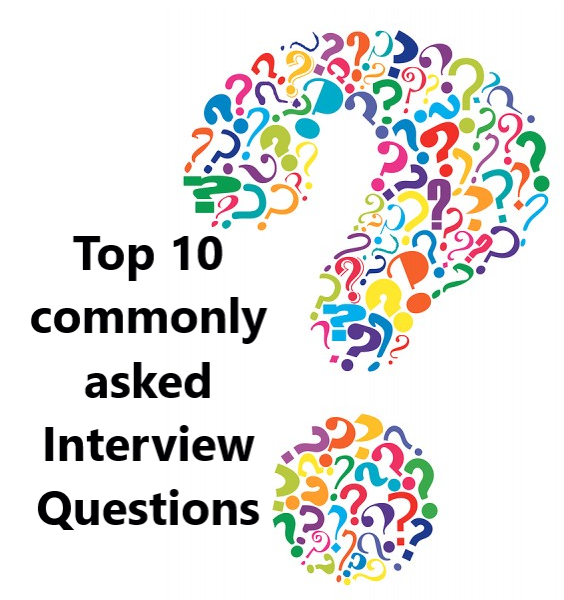
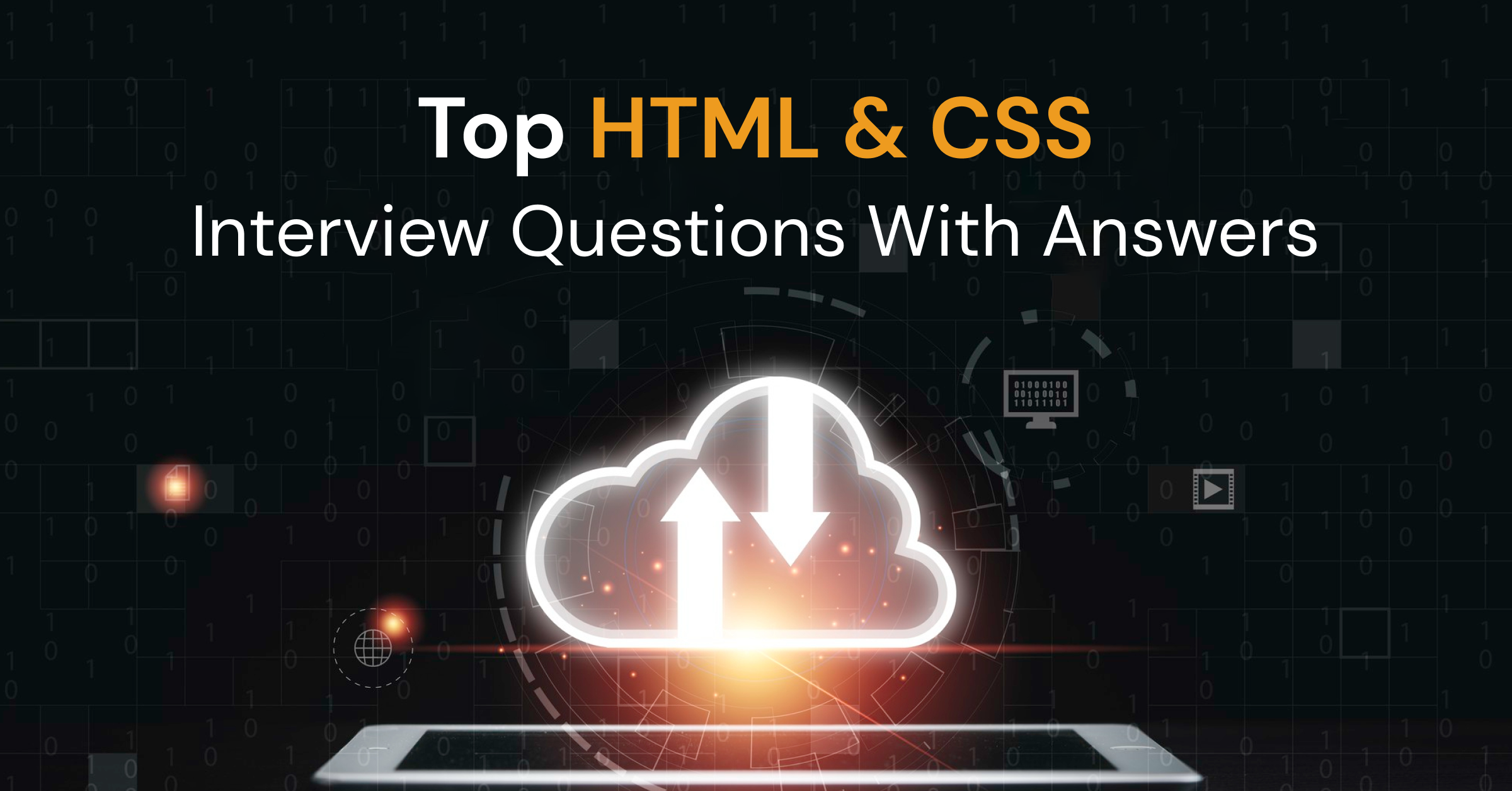

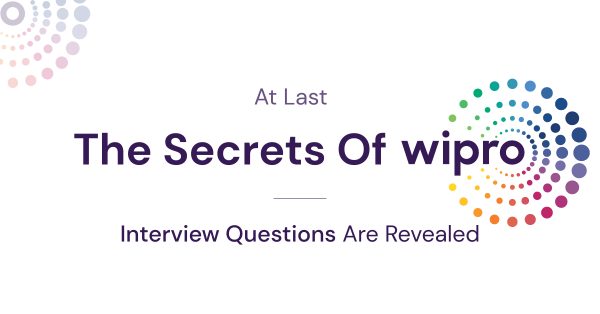


![Top React Interview Questions and Answers! [Updated] 10 React Interview Questions](https://www.guvi.in/blog/wp-content/uploads/2022/01/Top-React-Interview-Questions-and-Answers.webp)


Did you enjoy this article?